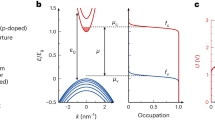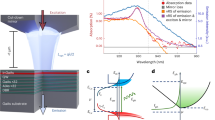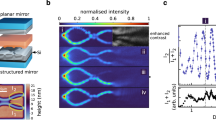Abstract
Bose–Einstein condensation (BEC)—the macroscopic ground-state accumulation of particles with integer spin (bosons) at low temperature and high density—has been observed in several physical systems1,2,3,4,5,6,7,8,9, including cold atomic gases and solid-state quasiparticles. However, the most omnipresent Bose gas, blackbody radiation (radiation in thermal equilibrium with the cavity walls) does not show this phase transition. In such systems photons have a vanishing chemical potential, meaning that their number is not conserved when the temperature of the photon gas is varied10; at low temperatures, photons disappear in the cavity walls instead of occupying the cavity ground state. Theoretical works have considered thermalization processes that conserve photon number (a prerequisite for BEC), involving Compton scattering with a gas of thermal electrons11 or photon–photon scattering in a nonlinear resonator configuration12,13. Number-conserving thermalization was experimentally observed14 for a two-dimensional photon gas in a dye-filled optical microcavity, which acts as a ‘white-wall’ box. Here we report the observation of a Bose–Einstein condensate of photons in this system. The cavity mirrors provide both a confining potential and a non-vanishing effective photon mass, making the system formally equivalent to a two-dimensional gas of trapped, massive bosons. The photons thermalize to the temperature of the dye solution (room temperature) by multiple scattering with the dye molecules. Upon increasing the photon density, we observe the following BEC signatures: the photon energies have a Bose–Einstein distribution with a massively populated ground-state mode on top of a broad thermal wing; the phase transition occurs at the expected photon density and exhibits the predicted dependence on cavity geometry; and the ground-state mode emerges even for a spatially displaced pump spot. The prospects of the observed effects include studies of extremely weakly interacting low-dimensional Bose gases9 and new coherent ultraviolet sources15.
This is a preview of subscription content, access via your institution
Access options
Subscribe to this journal
Receive 51 print issues and online access
$199.00 per year
only $3.90 per issue
Buy this article
- Purchase on SpringerLink
- Instant access to full article PDF
Prices may be subject to local taxes which are calculated during checkout




Similar content being viewed by others
References
Einstein, A. Quantentheorie des einatomigen idealen Gases. Zweite Abhandlung. Sitz. ber. Preuss. Akad. Wiss. 1, 3–14 (1925)
Anderson, M. H., Ensher, J. R., Matthews, M. R., Wieman, C. E. & Cornell, E. A. Observation of Bose–Einstein condensation in a dilute atomic vapor. Science 269, 198–201 (1995)
Davis, K. B. et al. Bose-Einstein condensation in a gas of sodium atoms. Phys. Rev. Lett. 75, 3969–3973 (1995)
Bradley, C. C., Sackett, C. A. & Hulet, R. G. Bose-Einstein condensation of lithium: observation of limited condensate number. Phys. Rev. Lett. 78, 985–989 (1997)
Deng, H., Weihs, G., Santori, C., Bloch, J. & Yamamoto, Y. Condensation of semiconductor microcavity exciton polaritons. Science 298, 199–202 (2002)
Kasprzak, J. et al. Bose–Einstein condensation of exciton polaritons. Nature 443, 409–414 (2006)
Balili, R., Hartwell, V., Snoke, D., Pfeiffer, L. & West, K. Bose-Einstein condensation of microcavity polaritons in a trap. Science 316, 1007–1010 (2007)
Demokritov, S. O. et al. Bose-Einstein condensation of quasi-equilibrium magnons at room temperature under pumping. Nature 443, 430–433 (2006)
Griffin, A., Snoke, D. W., Stringari, S., eds. Bose-Einstein Condensation (Cambridge University Press, 1995)
Huang, K. Statistical Mechanics 2nd edn 293–294 (Wiley, 1987)
Zel'dovich, Y. B. & Levich, E. V. Bose condensation and shock waves in photon spectra. Sov. Phys. JETP 28, 1287–1290 (1969)
Chiao, R. Y. Bogoliubov dispersion relation for a ‘photon fluid’: is this a superfluid? Opt. Commun. 179, 157–166 (2000)
Bolda, E. L., Chiao, R. Y. & Zurek, W. H. Dissipative optical flow in a nonlinear Fabry-Pérot cavity. Phys. Rev. Lett. 86, 416–419 (2001)
Klaers, J., Vewinger, F. & Weitz, M. Thermalization of a two-dimensional photonic gas in a ‘white-wall’ photon box. Nature Phys. 6, 512–515 (2010)
Jonkers, J. High power extreme ultra-violet (EUV) light sources for future lithography. Plasma Sources Sci. Technol. 15, S8–S16 (2006)
Siegman, A. E. Lasers (University Science Books, 1986)
Ketterle, W., Durfee, D. S. & Stamper-Kurn, D. M. in Bose–Einstein Condensation in Atomic Gases (eds Inguscio, M., Stringari, S. & Wieman, C. E., ) CXL, 67–176 (Proceedings of the International School of Physics “Enrico Fermi”, IOS Press, 1999)
De Angelis, E., De Martini, F. & Mataloni, P. Microcavity superradiance. J. Opt. B 2, 149–155 (2000)
Yokoyama, H. & Brorson, S. D. Rate equation analysis of microcavity lasers. J. Appl. Phys. 66, 4801–4805 (1989)
Bagnato, V. & Kleppner, D. Bose-Einstein condensation in low-dimensional traps. Phys. Rev. A 44, 7439–7441 (1991)
Mullin, W. J. Bose-Einstein condensation in a harmonic potential. J. Low-Temp. Phys. 106, 615–641 (1997)
Lakowicz, J. R. Principles of Fluorescence Spectroscopy 2nd edn, 6 (Kluwer Academic/Plenum, 1999)
Hadzibabic, Z. & Dalibard, J. Two-dimensional Bose fluids: an atomic physics perspective. Preprint at 〈http://arxiv.org/abs/0912.1490〉 (2009)
Hadzibabic, Z., Krüger, P., Cheneau, M., Battelier, B. & Dalibard, J. Berezinskii–Kosterlitz–Thouless crossover in a trapped atomic gas. Nature 441, 1118–1121 (2006)
De Martini, F. & Jacobovitz, G. R. Anomalous spontaneous–stimulated-decay phase transition and zero-threshold laser action in a microscopic cavity. Phys. Rev. Lett. 60, 1711–1714 (1988)
Yokoyama, H. et al. Controlling spontaneous emission and threshold-less laser oscillation with optical microcavities. Quantum Electron. 24, S245–S272 (1992)
Yamamoto, Y., Machida, S. & Björk, G. Micro-cavity semiconductor lasers with controlled spontaneous emission. Opt. Quantum Electron. 24, S215–S243 (1992)
Kocharovsky, V. V. et al. Fluctuations in ideal and interacting bose–einstein condensates: from the laser phase transition analogy to squeezed states and Bogoliubov quasiparticles. Adv. At. Mol. Opt. Phys. 53, 291–411 (2006)
McCumber, D. E. Einstein relations connecting broadband emission and absorption spectra. Phys. Rev. 136, A954–A957 (1964)
Einstein, A. Zur Quantentheorie der Strahlung. Physik . Zeitschr. 18, 121–128 (1917)
Acknowledgements
We thank J. Dalibard and Y. Castin for discussions. Financial support from the Deutsche Forschungsgemeinschaft within the focused research unit FOR557 is acknowledged. M.W. thanks the IFRAF for support of a guest stay at LKB Paris, where part of the discussion on interacting two-dimensional photon gases was developed.
Author information
Authors and Affiliations
Contributions
J.K. and M.W. contributed to the experimental idea; J.K. carried out the experiments. J.S. contributed to the experimental set-up. All authors analysed the experimental data and discussed the results.
Corresponding author
Ethics declarations
Competing interests
The authors declare no competing financial interests.
Rights and permissions
About this article
Cite this article
Klaers, J., Schmitt, J., Vewinger, F. et al. Bose–Einstein condensation of photons in an optical microcavity. Nature 468, 545–548 (2010). https://doi.org/10.1038/nature09567
Received:
Accepted:
Published:
Issue date:
DOI: https://doi.org/10.1038/nature09567
This article is cited by
-
Double dome structure of the Bose–Einstein condensation in diluted S = 3/2 quantum magnets
Nature Communications (2023)
-
Cosmological mass of the photon and dark energy as its Bose–Einstein condensate in de Sitter space
Indian Journal of Physics (2023)
-
Dispersive and dissipative coupling of photon Bose-Einstein condensates
Communications Physics (2022)
-
Mean-field theory of social laser
Scientific Reports (2022)
-
An Ising machine based on networks of subharmonic electrical resonators
Communications Physics (2022)




Dilip G. Banhatti
Are these photons which condensed into the BEC pure photons or quasi-particles of some kind?
[See (1)Ottfried Madelung's (1996 Springer) book "Introduction to Solid State Theory" and
(2) M I Kaganov (1979 & later Mir) "Quasiparticles" + same author (1981 Mir) "Electrons, Phonons, Magnons"]
Martin Weitz
According to some definitions every light propagating through matter is a polariton, while other authors (e.g: Refs.5-7) use this term to indicate strong coupling between light and matter. Our experiment is far from the strong coupling regime because the decoherence time of the dipole is of femtosecond timescale, so that the light-matter system is not in a pure quantum state. In the sense of the second definition we clearly deal with photons instead of polaritons, whereas in the sense of the first basically no pure photons exist.
D. C. Dai
This structure is same as a traditional laser, in which two mirrors confine the specific photons (frequency) inside the cavity, and lasing is observed as the pump power reaches a threshold.
BEC is a result of spontaneous coherence. The BEC of photons claimed here in a microcavity has been extensively reported as the BEC of exciton/polaritons in micro-cavity, the latter case is a typical Driven-BEC.
Martin Weitz
We agree that our setup is similar to realizations of the laser, but point out that the physics is strikingly distinct from a device described by common laser theory (Ref. 16). Other than in a laser both the light field and the state of the medium are in thermal equilibrium. We operate in a spectral region with strong dye reabsorption. A crucial point is the small spacing between mirrors, giving a low frequency cutoff with a continuum of modes above. In our paper several lines of evidences for a BEC are given. For example, the usual condition for the emergence of a coherent peak in a laser, of the gain coefficient exceeding the loss, is here replaced by Eq. (1), which essentially is equivalent to: n*lamda_db^2, i.e. that the de Broglie wavepackets of the photon gas spatially overlap; see Fig. 3 and corresponding discussion for experimental verification. The polariton BEC experiments (Ref. 5-7) use strong coupling of matter and light. This is because thermalisation is achieved by interparticle interactions of the matter proportions of the polaritons. The thermalisation is different in our case, no matter proportion is needed. Thermalisation proceeds with a bath: Photons collide with distinct dye molecules dissolved in a solution. Does it here make sense to talk about collisions of solvent-photon polaritons with dye-molecules? With the same arguments of yours, the terminology of a 'photon laser' should be replaced by a 'polariton laser', because in the active medium the light necessarily transmits matter, and a 'dye laser' would be a 'dye polariton laser'. To us authors belief, the description of terms of photons is much more appropriate, which is common terminology in laser physics (Ref.16). Note also the strong transverse dye decoherence. As was shown in earlier work (Ref. 14), several lines of evidence show that the photon gas observed in our experiment is very well described by an equilibrium distribution; also for the thermal part of the photon gas. A 'driven BEC' thus does not capture the point, however our experiment may well be described in terms of a 'continuous-wave BEC', an issue that has not yet been achieved for atomic gases. Both the spectral and the spatial distribution are basically the same as expected for a thermalized gas in a corresponding ideal 'photon box', with no losses and pumping. This is because the thermalisation proceeds faster than loss and gain.
Peter Buch
In reply to Dilip G. Banhatti's question "Are these photons which condensed into the BEC pure photons or quasi-particles of some kind?", Martin Weitz pointed out that the light-matter coupling is weak, so that the particles in question are not polaritons in a meaningful sense, and thus are photons. Anyway, I think the "photons" in the experiment are quasi-particles of some other kind. There is a strong coupling between the cavity and every photon, resulting in something that is massive and two-dimensional. It might be called a transversal-modon.
Ang Yu
In reply to Peter Buch,
If this can be considered as quasi-particle, how do we distinguish pure photons and quasi-particles?